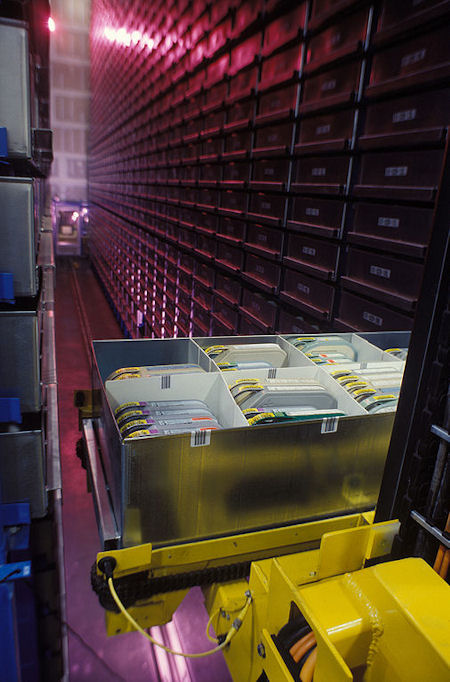Automated Storage and Retrieval System (AS/RS)
Automated Storage and Retrieval Systems are systems linked to a computerized control with an automated method of retrieving items from a designated storage location. The principle is that the machine rather than a person does the searching and retrieving.
Most AS/RS units make significant use of vertical space, leading to a high storage density.

AS/RS from the Defense Visual Information Center

These systems have some benefit but are also somewhat at odds with Lean culture if used inappropriately. One of the main reason to create an automated system is when a company holds a lot of inventory. Lean promotes the opposite of having lots of material on hand. In addition, an AS/RS stacks things away—Lean says make things visible.
In most good Lean production systems, you should be working hard to get away from needing an AS/RS. However, there are some applications where these may be appropriate to use.
In general, due to the expense, they are used primarily when extensive storage is needed, or when there are frequent retrievals. Its best applications is in processes involving archiving, or in distribution of a large number of SKUs. Retrieving patient records, storing books in a library, or archival of corporate documents are all valid applications, especially when the volume is large. Regional distribution centers or online merchants also generally benefit from using an AS/RS.
The systems can range greatly in size from handling files up to pallets and beyond. Some parking garages even use these sorts of systems in dense urban areas where space is at a premium.
The benefits of the AS/RS include efficient use of space, efficient retrieval of materials, and better safety. Opportunities for injury exists whenever people are going up in the air for anything, whether on a ladder or on a lift. Machines also drop fewer items than a person would, and if they do, there are likely no humans in the drop zone.

These systems have a relatively high initial cost. The financial calculations rely on many assumptions about savings. Often, these assumptions can be contrary to Lean principles, creating a barrier to improvement.
An AS/RS is a monument and dictates processes. It can create barriers when flexibility is required.
Because you are probably limited by the number of vehicles the system can handle, you may run into capacity constraints. You can’t add people to speed up your operation beyond what the system is capable of handling.
Maintenance is critical. A breakdown can shut down an operation. This problem will, in most cases, increase as the machine ages. Problematically, this happens while the need for the system likely rises with the growth of the company.
The stored items are out of sight, so it is harder to manage the operation visually. Great industrial discipline is required by anyone accessing the materials to log what goes in and out of storage.
Large storage areas tend to accumulate materials. People have a tendency to become packrats when an AS/RS is available for general storage.


0 Comments